HTPC - TV Tuner Reviews
by Jarred Walton on December 7, 2005 12:05 AM EST- Posted in
- Smartphones
- Mobile
Image Quality Comparison
Comparing image quality among these cards is inherently a subjective task. Without investing in hundreds of dollars of hardware, you can't do a direct side by side comparison of the same video. In our last TV tuner round-up, Anand used content from CNN, since it loops about every 30 minutes. I'm less of a CNN-type person, so I choose to use content from various football games for the samples. Football has the added advantage of providing fast-paced video. Watching the camera pan down the football field stresses the codec, and you get the added benefit of being able to find many football games broadcast in 1080i and 720p HDTV.
Starting with the analog content, we have six sample points: FusionHDTV; MyHD using the Sempron, 4000+ and the X2 3800+; and finally two from the Theater 550 Pro. We set all configurations to use the best encoding possible, though the MyHD was CPU limited when running without the X2, resulting in very low encoding settings.
Looking at the full-size images, it should be pretty obvious that the Theater 550 provides the best analog quality. The MyHD, analog quality is terrible on the 4000+ and even worse on the Sempron. However, the quality using the X2 is actually very good. The Fusion5 analog quality isn't bad, but one thing that the image can't convey is the audio. All of our analog captures using the Fusion5 have a high-pitched squeal throughout the video. This appears to be a problem with the Fusion HDTV software, so using a different application should fix the issue. As we've already hinted, analog only users will definitely want to get a quality analog card as opposed to something like the Fusion5 or the MyHD. That brings us to the HDTV captures.
There really isn't a whole lot to say about the digital quality of the cards, other than that HDTV images are vastly superior to any analog/SDTV broadcast. As long as the card can receive the transport stream, the quality should be identical to any other card that can receive the transport stream. The card doesn't have to do any encoding, so if the signal is clean, the quality is exceptional. We didn't get an example of the Fusion5 capturing 1080i content, but there shouldn't be any difference from the MyHD capture. What we did provide is an upsampled 1080i sample. Needless to say, if you start with a 480i video, more than doubling the resolution isn't going to provide a clean result.
Incidentally, if you do get a card that can record digital transport streams, you might want a cost-effective way to play the videos on another HDTV. A $500 computer could probably get the job done, but you might not want another PC. Here's a home theater device that can play DVDs, DivX files, MPEG-1/2, and WMV9 (unprotected) videos. It can also handle TS/PS files (which are just a variant of MPEG-2). More importantly, it can do all this through the 10/100 Mbit network connection. If there's enough interest, we'll try to get one for review.
Comparing image quality among these cards is inherently a subjective task. Without investing in hundreds of dollars of hardware, you can't do a direct side by side comparison of the same video. In our last TV tuner round-up, Anand used content from CNN, since it loops about every 30 minutes. I'm less of a CNN-type person, so I choose to use content from various football games for the samples. Football has the added advantage of providing fast-paced video. Watching the camera pan down the football field stresses the codec, and you get the added benefit of being able to find many football games broadcast in 1080i and 720p HDTV.
Starting with the analog content, we have six sample points: FusionHDTV; MyHD using the Sempron, 4000+ and the X2 3800+; and finally two from the Theater 550 Pro. We set all configurations to use the best encoding possible, though the MyHD was CPU limited when running without the X2, resulting in very low encoding settings.
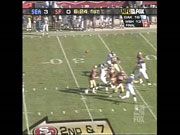 MyHD Sempron |
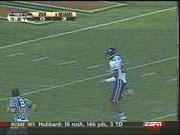 MyHD 4000+ |
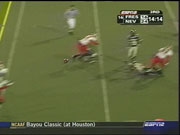 MyHD X2 3800+ |
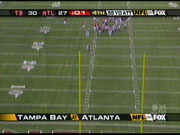 Fusion5 |
 Theater 550 |
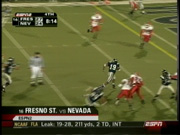 Theater 550 |
| Click on images to enlarge. | ||
Looking at the full-size images, it should be pretty obvious that the Theater 550 provides the best analog quality. The MyHD, analog quality is terrible on the 4000+ and even worse on the Sempron. However, the quality using the X2 is actually very good. The Fusion5 analog quality isn't bad, but one thing that the image can't convey is the audio. All of our analog captures using the Fusion5 have a high-pitched squeal throughout the video. This appears to be a problem with the Fusion HDTV software, so using a different application should fix the issue. As we've already hinted, analog only users will definitely want to get a quality analog card as opposed to something like the Fusion5 or the MyHD. That brings us to the HDTV captures.
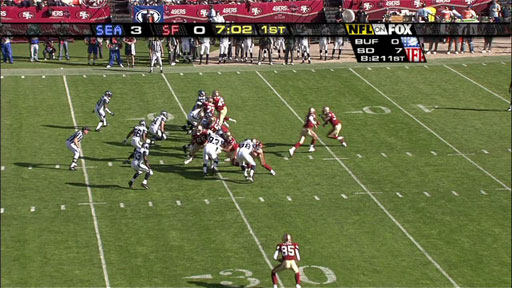 MyHD 720p |
 Fusion5 720p |
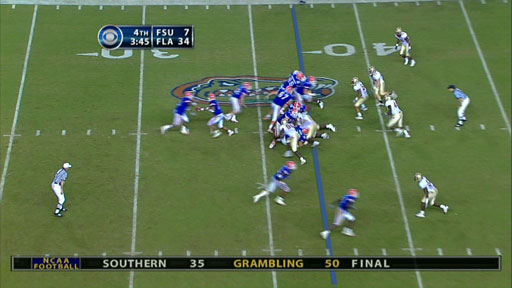 MyHD 1080i |
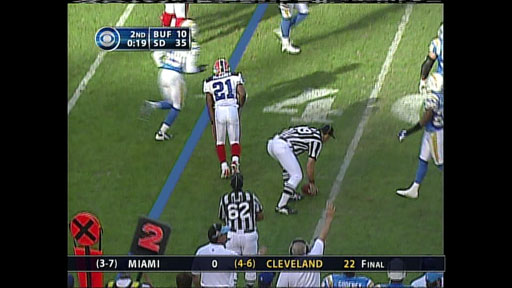 MyHD 1080i - upsampled 480i |
| Click on images to enlarge. |
There really isn't a whole lot to say about the digital quality of the cards, other than that HDTV images are vastly superior to any analog/SDTV broadcast. As long as the card can receive the transport stream, the quality should be identical to any other card that can receive the transport stream. The card doesn't have to do any encoding, so if the signal is clean, the quality is exceptional. We didn't get an example of the Fusion5 capturing 1080i content, but there shouldn't be any difference from the MyHD capture. What we did provide is an upsampled 1080i sample. Needless to say, if you start with a 480i video, more than doubling the resolution isn't going to provide a clean result.
Incidentally, if you do get a card that can record digital transport streams, you might want a cost-effective way to play the videos on another HDTV. A $500 computer could probably get the job done, but you might not want another PC. Here's a home theater device that can play DVDs, DivX files, MPEG-1/2, and WMV9 (unprotected) videos. It can also handle TS/PS files (which are just a variant of MPEG-2). More importantly, it can do all this through the 10/100 Mbit network connection. If there's enough interest, we'll try to get one for review.










77 Comments
View All Comments
8steve8 - Wednesday, December 7, 2005 - link
bottom line:if i want to watch/record hdtv channels like HBO and/or discover via a PC...
im out of luck?
those channels are not ota... are provided through a cable provider....
i can do this once cable card finally comes around?
JarredWalton - Wednesday, December 7, 2005 - link
HBO and most other movie channels are encrypted. Funny enough, some of the on demand channels seem to be picked up. For instance channels 101-1, 101-2, 102-1, 102-2, and several subchannels on the physical channels 93 and 94 all showed what amounts to random content. Movies, cartoons, and yes, even porn. If you tuned in to one of the channels, sometimes you would see it going to fast-forward mode, like the person watching the content was skipping ahead.Cable card is supposed to allow you to view encrypted content on TVs as well as computers without a set-top box. Until I see it in actual use, though, I'm not exactly sure how it's going to work. I would assume it will just store an encrypted TP file, and the cable card will contain the decryption logic.
nullpointerus - Wednesday, December 7, 2005 - link
http://en.wikipedia.org/wiki/Cablecard">http://en.wikipedia.org/wiki/CablecardI've been waiting for decent HTPC CableCard products for ~2 years now. They'll probably come out very late in 2006, achieve their intended interoperability sometime between the second and third generation of products, and become practically flawless around the same time that they become obsolete. That's just a guess, mind you...
Tujan - Wednesday, December 7, 2005 - link
It was intriging because nobody has really compared the use of DIY HTPCs. With what limited parts are available.I wouldn't use a non-multicore processor for something dealing with HDPCs. Just the shear amount of graphics and screen space,the relative newcomer to its display of screen space,. The notorious 'switching between apps,and those running in the background,- much less using the PCI bus to do so.
What I did miss out of this story,was a shot of a connected MYHD130 to its screen display. Kind of lost me there. With the connect ups to utilizing a screen,and the computers video card. See Im reading imagining toggling between user interface,remote,and what this means to the rigging of separate devices outside the computer itself.Caveat Emptor for/from them along side. And you mentioned that ATI was 'out-of-the-picture , for HDTV unless the components where hooked up. So to share that ATI graphics cards are not useful for the MYHD130.
Would certainly make a wish list to the MYHD130 to put it onto the PCI-e lane.Get it off the PCI bus.
As for those encrypted channels.Are you sure they would stay that way ? Think you could pick out your PPV (Pay-Per-view) channel from that list ? [ ]
You mentioned your Monitor,that they have in common Overscan.I simply have the question included to involve just how a HTPC will correctly recognize a monitor (consider a 32 to 40" LCD TV) ,when most this involves the PNP feature Ive known for doing so.? [ ]
ATI cards aren't any good with the DTV if using the DVI for/from them for the HD screens ? Think 32" to 42" LCD TVs here.[ ]
- glad your doing the experimenting here.Good article.
JarredWalton - Wednesday, December 7, 2005 - link
LCD TVs shouldn't have a problem with overscan. Any rear projection displays will have overscan, and I believe all DLP have overscan as well. There are some good DLP displays that only have 1% overscan, though -- too bad they're really expensive.If you want a picture of what the MyHD looks like when connected, let me see about uploading one and I'll provide a link. This is with the DVI daughter card:
http://images.anandtech.com/reviews/multimedia/tvt...">DVI Passthru Image
http://images.anandtech.com/reviews/multimedia/tvt...">VGA Passthru Image
Hopefully that's clear - there's a lot of cable clutter, so I labeled the pertinent connections.
Tujan - Wednesday, December 7, 2005 - link
Thanks for reply. Even though I know a lot,Im still a novice. Know a lot of the acronymns,but dealing with things marketed off the top just keeps me on to them for a limited span.The picture there,the top card is the video card,with the lower cards being the TV tuners then.Im thinkin that somehow your giving up a controlled connection to your display from the computer by using the MyHD130 ? Or it limits the 'out of your video card when you only would have a single hook up on the Display.[ ]
- I will go to there site to look for more.
Encryption ? [ ] Mean if you subscribe to HBO via your home cable line,HBO will not be able to be seen if utilizing the HTPC with the QAM/HD TV cards ?
Certainly the situation would be averted for the configuration of the cable to Display(cable box to default display) - since (T,F) the Display has an encryption chip within it to do so,(1),or (2) Encryption is handled via the cable box. With everything else dealing with something of the HDCP,HDMI type scenarios.... The encryption mechanism has got to work somewhere in the final render at the Display. Certainly the Cable Company isn't selling me the Display.....
Of course this is a whole nother anchalotta.
I pretty much just look for the configuration compatibility in the input,output for the hookups.And if the software will work/..how difficult to navigate them.
Thinking everythings hunky dory after a large investment ...Again thanks for reply.
JarredWalton - Wednesday, December 7, 2005 - link
Decryption of the encrypted channels is handled by the cable box. The cable card standard will allow other devices to do that decryption -- basically, the key/algorithm will be stored on the cable card. Of course, that means you need to have a TV and or computer that has a cable card slot. Hopefully they'll make a USB adapter.mariush - Wednesday, December 7, 2005 - link
I'm a bit dissapointed that you have used Divx to test the analog recording. XViD would have probably been much faster, at least that's how it is on my computer.Also, I would probably either use XViD set to record with quantizer 1 (max quality) which takes about 6-10 MB/s at 768x576 25fps or I would use a lossless encoder such as HuffYUV (~12 MB/s at 768x576 25fps)
JarredWalton - Wednesday, December 7, 2005 - link
The DivX codec is officially supported by the MyHD software. Xvid was far slower, and that holds in general, unless there is a special setting to get it to encode faster. All the real-time encoding has to be done through a VFW codec, and I couldn't find a fast codec to handle that. The DivX codec is also the only codec that allows you to resize the video content, at least as far as I could tell. Otherwise you end up with an incorrect aspect ratio, as seen on the top left picture on page 15.If you download the videos, you might feel that the DivX codec results in a loss of quality, even on the X2 system. That video sample is actually very close to what you see when watching live analog content with the MyHD card. At best, it's decent analog video. Just about any analog-only TV tuner will produce equal or better output.
Back to the codecs, if you really want to get a decent compression, while not losing a lot of quality, I would recommend using a second PC or re-encoding the videos while your computer is sitting idle. You could do the same thing with the TP files, re-encoding them using the Xvid codec with a data rate of around 1 GB per hour and the target, resolution of 720 x 480 -- or perhaps go for 2/3 GB per hour and target a 1280x1024 resolution.
One of the benefits of the DivX codec is that quite a few consumer-electronics devices now support it as well. I'm not aware of any DVD players that can handle Xvid.
xtknight - Wednesday, December 7, 2005 - link
Sorry for the double post, but by the way, the program AVI.NET can encode xvid and divx for standalone players. That's the whole purpose of it: to use only the features standalone players support. I recommend you try it out.